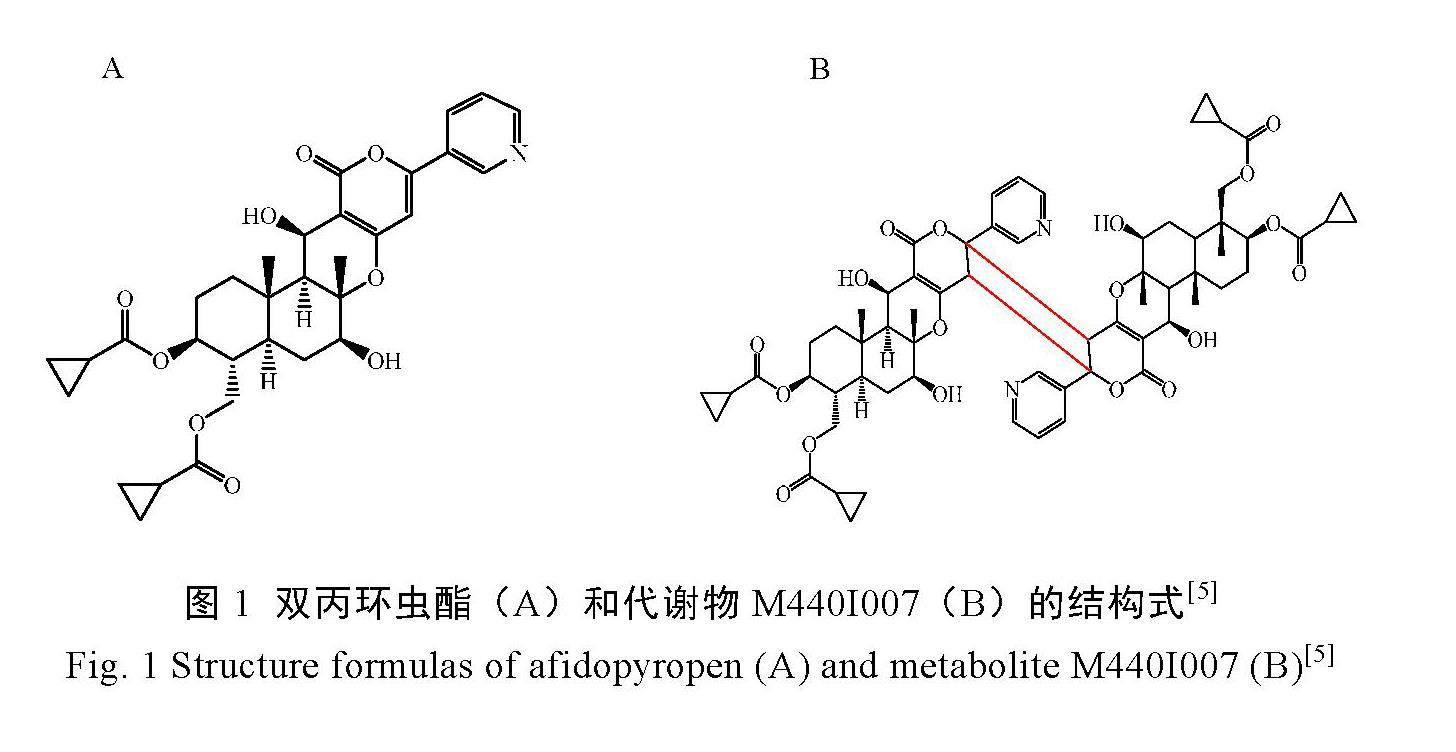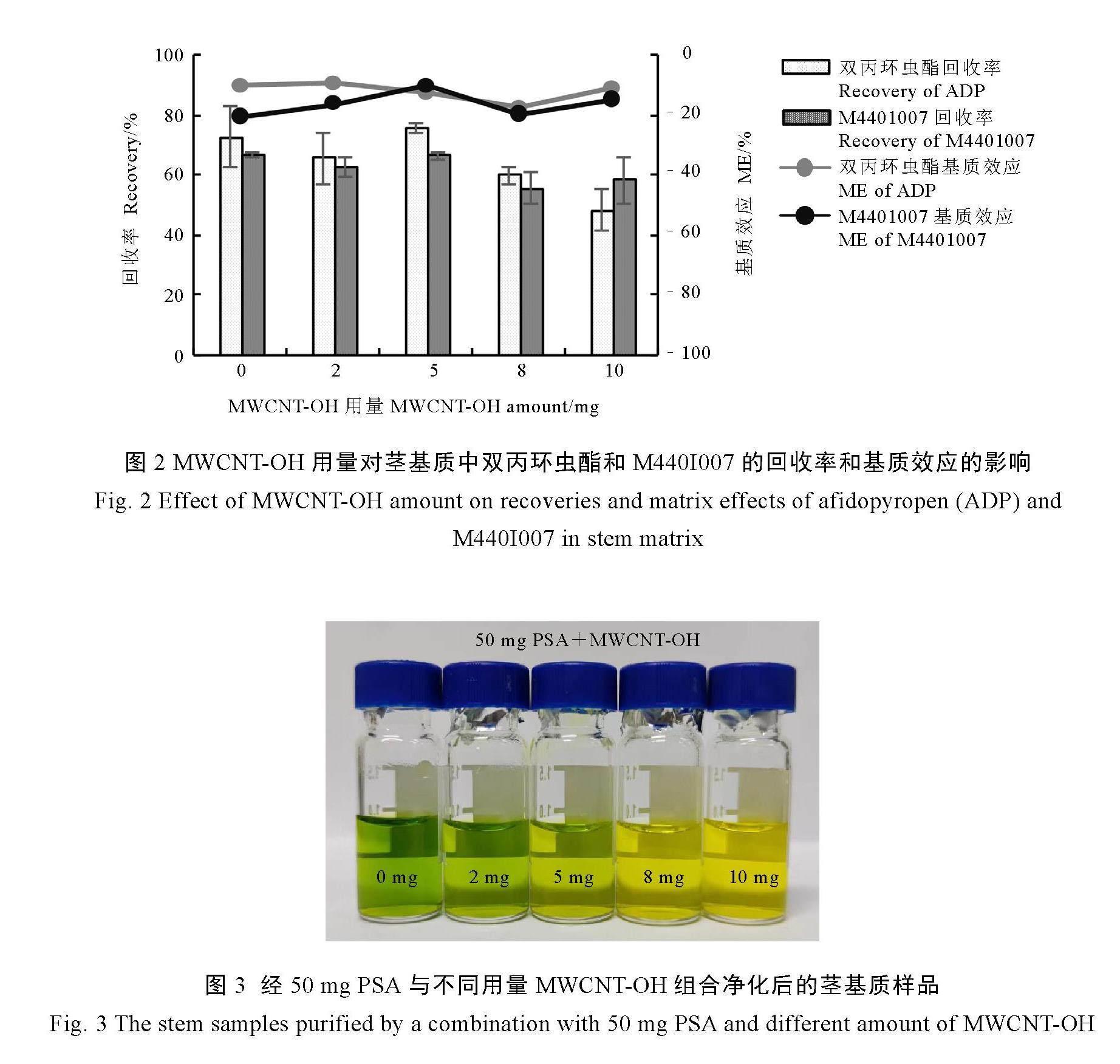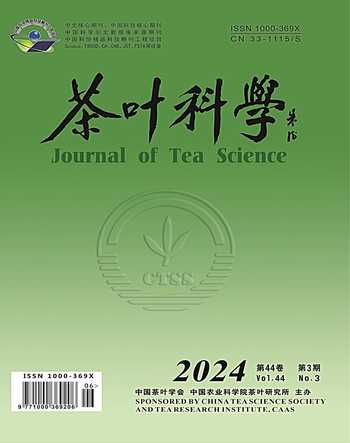改良QuEChERS方法结合超高效液相色谱串联质谱测定茶树组织中的双丙环虫酯和代谢物M440I007
秦钰洁 郭明明 陈永晶 周利



摘要:双丙环虫酯是一种新型生物源杀虫剂,2023年在我国登记用于茶树中茶小绿叶蝉的防治。建立了改良QuEChERS法结合超高效液相色谱-串联质谱法(UPLC-MS/MS)测定茶树组织中双丙环虫酯及其代谢物M440I007的分析方法。茶树根、茎、叶经水和乙腈提取,N-丙基乙二胺(PSA)、羟基化多壁碳纳米管(MWCNT-OH)和石墨化炭黑(GCB)净化,目标物用UPLC-MS/MS多反应监测模式(MRM)测定,基质匹配标准曲线外标法定量。在0.002~5.000 mg·L-1范围内,两种化合物的线性关系良好,决定系数(R2)>0.999 5。在0.005~2.000 mg·kg-1的添加水平下,两种化合物的回收率为78.3%~106.0%,相对标准偏差(RSD)≤12.85%,方法的定量限(LOQ)和检出限(LOD)分别为0.005 mg·kg-1和0.002 mg·kg-1。采用该方法,测得盆栽施药处理土壤培养7 d的茶苗组织中双丙环虫酯的分布为根(0.102 mg·kg-1)>茎(0.078 mg·kg-1)>叶(0.007 mg·kg-1),其转运因子TFroot-stem和TFstem-leaf均小于1,代谢物M440I007的残留水平均在定量限以下。本研究建立的方法成本低、准确度和灵敏度高,可为进一步研究双丙环虫酯和M440I007在茶树中的吸收传导行为提供技术基础。
关键词:茶树;农残;双丙环虫酯;M440I007;检测方法
中图分类号:S571.1;S482 文献标识码:A 文章编号:1000-369X(2024)03-515-11
Determination of Afidopyropen and Metabolite M440I007 in Tea Tissues by Modified QuEChERS Coupled with Ultra-high Performance Liquid Chromatography-Tandem Mass Spectrometry
QIN Yujie1,2, GUO Mingming1,2, CHEN Yongjing3, ZHOU Li1*
1. Research Center of Quality Safety for Agricultural Products, Tea Research Institute, Chinese Academy of Agricultural Sciences, Hangzhou 310008, China; 2. Graduate School of Chinese Academy of Agricultural Sciences, Beijing 100081, China;
3. Hengzhou Jasmine Industry Service Center, Hengzhou 530300, China
Abstract: Afidopyropen, a novel biorational insecticide, was registered in China in 2023 for the control of tea leafhoppers in tea plantation. In this study, an analytical method was developed for the determination of afidopyropen and its metabolite M440I007 in tea tissues by a modified QuEChERS method combined with ultra-performance liquid chromatography-tandem mass spectrometry (UPLC-MS/MS). Roots, stems and leaves of tea plants were extracted by water and acetonitrile, and purified with primary secondary amine (PSA), hydroxylated multi-walled carbon nanotubes (MWCNT-OH) and graphitized carbon black (GCB). The target compounds were determined by UPLC-MS/MS in multiple reaction monitoring (MRM) mode, and quantified by external standard method with matrix-matched standard curve. Both targets display excellent linearity (R2>0.999 5) in the range of 0.002-5.000 mg·L-1. The recoveries of both compounds at the spiked levels of 0.005-2.000 mg·kg-1 ranged from 78.3% to 106.0% with the relative standard deviations (RSD) ≤ 12.85%. The limits of quantification (LOQs) and detection (LODs) of the method were 0.005 mg·kg-1and 0.002 mg·kg-1, respectively. The developed method was applied to detect afidopyrofen and M440I007 in tea seedling tissues cultured in soil treated with afidopyropen in a pot experiment for 7 days. The results show that the distribution of afidopyropen in the tissues was roots (0.102 mg·kg-1) > stems (0.078 mg·kg-1) > leaves (0.007 mg·kg-1). The translocation factors, TFroot-stem and TFstem-leaf, were both less than 1, and the residue levels of the metabolite M440I007 were below the LOQ. The method established in this study is low-cost, accurate and sensitive, which can serve as a technical basis for further research on the uptake and transport behaviors of afidopyropen and M440I007 in tea plants.
Keywords: tea plant, pesticide residues, afidopyropen, M440I007, detection method
环境中的农药残留能被植物吸收并在体内富集造成植物中的农药残留污染[1],监测植物组织中的农药水平对评价其在植物中的吸收、传导,以及对后茬作物的影响及植物中农药残留的来源追溯具有重要意义。双丙环虫酯是一种新型生物源杀虫剂[2],于2023年9月在茶树上登记用于茶小绿叶蝉的防治[3],其在茶树叶片上会代谢产生与其毒性相似的M440I007[4-5]。M440I007是双丙环虫酯在植物体中的主要代谢物,二者结构式如图1所示。此外,双丙环虫酯在环境中具有中等持久性[6],随着双丙环虫酯在我国茶园的推广使用,茶园环境中的双丙环虫酯可能被茶树吸收并在茶树组织中转运,所以开发茶树组织中双丙环虫酯和M440I007的快速灵敏检测方法十分必要。
目前,样品中农药残留检测的前处理技术有液液萃取(LLE)[7]、固相萃取(SPE)[8]、固相微萃取(SPME)[9]和分散固相萃取(d-SPE)[10]等。其中,LLE操作简单,但溶剂用量大、净化效果不好[11]。SPE净化能力强,但消耗溶剂且固相萃取柱价格较高[12]。SPME虽然无需使用溶剂,但萃取头成本较高[13]。d-SPE具有操作简单快速、溶剂用量少、应用成本低等优点,基于此技术开发的QuEChERS前处理方法被广泛应用于植物源样品中的农
药残留分析[14-16]。对双丙环虫酯和M440I007检测方法的研究较少,主要集中在果蔬[17-22]、小麦[23]和棉花[24]等简单基质上。对复杂基质中双丙环虫酯和M440I007的检测方法研究,仅Guo等[25]建立了茶叶中目标物经水和乙腈提取,固相萃取柱TPT净化的分析方法,但该法中有机溶剂的使用量较大、TPT柱的成本较高。
本研究拟建立一种低成本的改良QuEChERS结合UPLC-MS/MS方法检测茶树组织中双丙环虫酯和代谢物M440I007残留的分析方法,为探究其在茶树体内的吸收传导行为提供参考。
1 材料与方法
1.1 仪器与试剂
UPLC/Quattra Premier XE超高效液相色谱-三重四极杆质谱联用仪,ESI源,Mass Lynx 4.1 质谱工作站软件(美国Waters公司);Acquity UPLC HSS-T3色谱柱(100 mm×2.1 mm,1.8 ?m,美国Waters公司);DFT-200食品粉碎机(温岭市林大机械有限公司);Votertex Genie-2涡旋振荡器(美国Scientific industries公司);KQ-500DE超声波清洗机(昆山市超声仪器有限公司);高速离心机(德国Sigma公司);R-210旋转蒸发仪(瑞士Buchi公司);0.22 μm有机滤膜(天津博纳艾杰尔科技有限公司)。
双丙环虫酯标准品(纯度98.7%)、M440I007标准品(纯度90.2%)、50 g·L-1双丙环虫酯可分散液剂购自巴斯夫欧洲公司,乙腈(色谱纯)购自赛默飞世尔科技(中国)有限公司,甲酸(色谱纯)购自CNW Technologies GmbH公司,纯净水购自杭州娃哈哈集团有限公司,N-丙基乙二胺(PSA,40~63 μm)购自上海安谱实验科技股份有限公司,羟基化多壁碳纳米管(MWCNT-OH,50 nm)购自中国科学院成都有机化学有限公司,石墨化炭黑(GCB,120~400目)购自天津博纳艾杰尔科技有限公司。
1.2 标准溶液配制
分别称取双丙环虫酯和M440I007标准品于10 mL容量瓶,色谱纯乙腈溶液定容后摇匀,配制成200 mg·L-1单标准品储备溶液。分别吸取两种化合物单标准品储备液于25 mL容量瓶,色谱纯乙腈溶液定容后摇匀,配制成50 mg·L-1混合标准品储备液。用色谱纯乙腈逐级稀释成10.00、1.00、0.10、0.01 mg·L-1系列混合标准品工作溶液。
1.3 试验方法
1.3.1 盆栽试验方法
利用盆栽模拟试验收集茶树根、茎、叶样品。向150 mL水中加入600 μL双丙环虫酯农药乙腈溶液(0.5 g·L-1),充分混合后倒入1.5 kg土壤(采于中国农业科学院茶叶研究所茶园,风干后过10目筛),搅拌均匀,使其在土壤中的质量分数为0.2 mg·kg-1。含药土壤装至底部垫有滤纸的花盆后,选择长势大致相同的茶苗移栽,浇水使茶苗培养期间的土壤含水率约为25%[26],设置无药土壤作为对照组。称重法每天补水至初始重量,7 d后采集3株茶树样品,用清水将根系土壤冲洗干净,然后用滤纸擦干,分离根、茎和叶,分别称重记录,均质后在﹣18 ℃冰箱中冻存,待测。
1.3.2 样品前处理
根和茎基质样品(一次净化):分别称取0.50 g根或茎(不含叶)磨碎样品于50 mL离心管,加入2 mL水,涡旋混匀静置15 min后加入10 mL乙腈,振荡5 min,超声提取15 min后加入2 g氯化钠,涡旋2 min,于10 000 r·min-1离心5 min。取全部上清液于含有净化剂(根为50 mg PSA,茎为50 mg PSA+5 mg MWCNT-OH)的10 mL离心管中,涡旋1 min,于10 000 r·min-1离心5 min。取8 mL上清液于40 ℃旋转蒸发浓缩至干燥,加入1 mL乙腈溶解残渣,过0.22 μm有机滤膜,待UPLC-MS/MS测定。
鲜叶基质样品(二次净化):称取0.50 g鲜叶磨碎样品于50 mL离心管,加入2 mL水,涡旋混匀静置15 min后加入10 mL乙腈,振荡5 min,超声提取15 min后加入2 g氯化钠,涡旋2 min,于10 000 r·min-1离心5 min。取全部上清液于含有净化剂(200 mg PSA+5 mg MWCNT-OH)的10 mL离心管中,涡旋1 min,于10 000 r·min-1离心5 min。取8 mL上清液于40 ℃旋转蒸发浓缩至干燥,加入1 mL乙腈溶解残渣。溶液转移至含有10 mg GCB的2 mL离心管中,涡旋1 min,于12 000 r·min-1离心5 min,过0.22 μm有机滤膜,待UPLC-MS/MS测定。
1.3.3 色谱条件
Acquity UPLC HSS-T3色谱柱(100 mm×2.1 mm,1.8 ?m),柱温40 ℃,进样量5 μL,样品室温度10 ℃。流动相A为0.1%甲酸乙腈,流动相B为纯净水。梯度洗脱程序:0 min(5% A)→0.5 min(30% A)→3.0 min(70% A)→5.0 min(85% A)→6.0 min(99% A)→7.5 min(5% A,保持1.5 min),流速0.25 mL·min-1。
1.3.4 质谱条件
采用电喷雾电离ESI+模式MRM测定;电喷雾电压3.5 kV;离子源温度150 ℃;脱溶剂气温度350 ℃;锥孔反吹气为N2;流量50 L·h-1;脱溶剂气为N2,流量700 L·h-1;碰撞气为Ar,流量0.35 mL·min-1;倍增电压650 V。其他参数见表1。
1.4 数据处理
基质效应(Matrix effect,ME)是指样品本身所含物质干扰目标分析物检测信号的现象。计算公式为ME=(k2/k1-1)×100%,k1为纯溶剂标准曲线的斜率,k2为基质匹配标准曲线的斜率。一般认为,|ME|≤20%时为弱基质效应,20%<|ME|≤50%为中等基质效应,|ME|>50%为强基质效应[25,27]。
2 结果与分析
2.1 茎基质净化过程优化
PSA可以去除有机酸、茶多酚和少量色素等,常在QuEChERS方法中使用[28-29]。MWCNT-OH是一种新型羟基化碳材料,对色素有较强吸附性[27,30]。本研究考察了50 mg PSA与不同用量MWCNT-OH组合对茎基质中双丙环虫酯和M440I007回收率及基质效应的影响与色素去除的效果,结果如图2和图3所示。50 mg PSA分别与0、2、5 mg MWCNT-OH组合下,双丙环虫酯和M440I007的回收率相差不大,随着MWCNT-OH用量的增加,M440I007的基质抑制效应逐渐减小。但是当MWCNT-OH用量增加到8 mg和10 mg时,双丙环虫酯和M440I007的回收率降低,小于60%,回收率较差,可能是由于高含量的MWCNT-OH对目标物质产生了较强的吸附[31]。在满足回收率的同时,MWCNT-OH用量为5 mg时的茎样品颜色最浅,故选择50 mg PSA+5 mg MWCNT-OH作为茎基质的净化剂。
2.2 叶基质净化过程优化
基于茎的净化剂用量对叶基质中PSA的
用量进行优化。由图4可知,随着PSA用量的增加,叶中双丙环虫酯和M440I007的回收率逐渐增加,两种化合物在叶中的基质抑制效应逐渐减小。当PSA用量为200 mg时,二者回收率达90.6%和95.0%,基质抑制效应降低至14.04%和26.65%,满足农药残留分析的要求,但此时叶基质样品的颜色仍然较深(图5B,0 mg GCB),大批量进样将加速色谱柱、仪器管路和检测器的污染,增加仪器维护频率,所以需对叶基质净化过程进一步优化。
GCB对色素类共提取物具有较好的去除效果[17],且应用成本低于MWCNT-OH,因此考察了在200 mg PSA+5 mg MWCNT-OH中直接组合GCB的一次净化方式对叶基质中双丙环虫酯和M440I007回收率、基质效应及色素去除的影响,结果如图5所示。增加GCB用量在30~70 mg范围,对双丙环虫酯和M440I007在叶基质中的基质效应和回收率改善不明显,样品中仍有较多色素。
加入净化剂的阶段可能会影响净化效果,因此试验中考察了GCB单独用于二次净化的效果,即在200 mg PSA+5 mg MWCNT-OH净化、1 mL乙腈溶解后使用GCB再次净化。如图6所示,二次净化中GCB用量对叶基质
中双丙环虫酯回收率的影响较大,当GCB用量由0增加到10 mg时,双丙环虫酯和M440I007的回收率均高于72.0%(图5A),且双丙环虫酯的基质抑制效应减小,溶液颜色变浅(图5B和图6B);继续增加GCB用量到30 mg和50 mg时,虽然溶液颜色持续变浅,但是双丙环虫酯的基质效应有所增加且回收率降低至60.0%以下,可能是高含量的GCB对目标物的吸附作用增强[24]。因此改变GCB的加入阶段,将其作为二次净化的净化剂应用于小体积净化以提高对共提取物的净化效果。试验中选用200 mg PSA+5 mg MWCNT-OH一次净化,结合10 mg GCB二次净化的方式对叶基质进行净化。
2.3 方法评价
2.3.1 方法的线性范围和基质效应
纯溶剂(乙腈)及基质(根、茎、叶)中双丙环虫酯和M440I007的线性方程、相关系数和基质效应如表2所示。在0.002~5.000 mg·L-1范围内,双丙环虫酯和M440I007在各基质中的线性良好,相关系数在0.999 5~1.000 0,基质抑制效应范围为31.56%~59.28%。本方法中茶基质对双丙环虫酯和M440I007主要表现为中等基质抑制效应,因此本研究采用基质匹配标准曲线进行定量分析以减少基质效应的干扰。以信噪比(S/N)>3的基质中可检出的最低浓度为LOD,双丙环虫酯和M440I007在茶树根、茎和叶中的LODs为0.002 mg·kg-1。
2.3.2 方法的准确度、精密度和定量限
茶树根、茎和叶中双丙环虫酯和M440I007的添加回收率和相对标准偏差如表3所示。4个添加水平(0.005、0.020、0.200、2.000 mg·kg-1)下,双丙环虫酯和M440I007在茶树根、茎和叶中的平均回收率为78.3%~106.0%,RSD为1.23%~12.85%,满足残留分析检测的准确度和精密度要求。以最低添加水平作为方法定量限(LOQ),双丙环虫酯和M440I007在茶树根、茎和叶中的LOQs为0.005 mg·kg-1。
2.4 盆栽试验结果
基于上述建立的农药残留分析方法,对在0.2 mg·kg-1双丙环虫酯的土壤中培养7 d的茶苗进行检测,结果如表4所示。茶苗根、茎和叶中双丙环虫酯的残留水平为根(0.102 mg·kg-1)>茎(0.078 mg·kg-1)>叶(0.007 mg·kg-1),双丙环虫酯在茶苗根、茎和叶中的分布存在差异,代谢物M440I007的残留水平均在定量限以下,可能因为施药浓度较低、试验时间较短或植株代谢缓慢,茶苗中的低母体残留产生的代谢物浓度较低。
以转运因子(Transfer factor,TF)评价茶树对目标化合物的传导能力,其计算公式为
TFroot-stem=Cstem/Croot,TFstem-leaf=Cleaf/Cstem,其中Croot、Cstem和Cleaf分别表示目标化合物在根、茎和叶中的残留水平,TFroot-stem表示目标化合物从根向茎的转运因子,TFstem-leaf表示目标化合物从茎向叶的转运因子[32]。双丙环虫酯的转运因子TFroot-stem和TFstem-leaf分别为0.796和0.102,说明双丙环虫酯从根向茎转运的能力大于从茎向叶的转运能力;但TFroot-stem和TFstem-leaf均小于1,表明目标化合物传导能力弱,双丙环虫酯不易从茶苗根中向上传导到茎和叶中。
3 结论
本研究通过比较不同净化条件对双丙环虫酯和M440I007回收率的影响,建立了水和乙腈提取,PSA、MWCNT-OH和GCB两步净化并结合超高效液相色谱-串联质谱测定茶树根、茎和叶中双丙环虫酯和M440I007的QuEChERS残留分析方法。该方法与TPT固相萃取法相比,减少了有机溶剂使用,降低了前处理技术的时间和耗材成本,具有简便、快速的优势。实际茶树根、茎、叶中目标化合物的测定结果表明,建立的改良QuEChERS法可应用于茶树组织中目标物的测定,为研究双丙环虫酯和M440I007在茶树中的吸收传导行为提供技术基础。
参考文献
262Affholder M C, Cohen G J V, Gombert-Courvoisier S, et al. Inter and intraspecific variability of dieldrin accumulation in Cucurbita fruits: new perspectives for food safety and phytomanagement of contaminated soils [J]. Science of the Total Environment, 2023, 859: 160152. doi: 10.1016/j.scitotenv.2022.160152.
263谭海军. 新型生物源杀虫剂双丙环虫酯[J]. 世界农药, 2019, 41(2): 61-64.
Tan H J. The novel biological insecticide afidopyropen [J]. World Pesticides, 2019, 41(2): 61-64.
264农业农村部农药检定所. 中国农药信息网[EB/OL]. [2024-3-2]. http://www.icama.org.cn/zwb/dataCenter.
Institute for the Control of Agrochemicals, Ministry of Agriculture and Rural Affairs. China pesticide information network [EB/OL]. [2024-3-2]. http://www.icama.org.cn/zwb/
dataCenter.
265Guo M M, Sun H Z, Wang X R, et al. Residue behavior and risk assessment of afidopyropen and its metabolite M440I007 in tea [J]. Food Chemistry, 2023, 404: 134413. doi: 10.1016/j.foodchem.2022.134413.
266FAO and WHO. Pesticide residues in food 2019-report 2019-joint FAO/WHO meeting on pesticide residues [EB/OL]. [2024-03-20]. https://www.fao.org/3/ ca7455en/
ca7455en.pdf.
267Keigwin R P. Final registration decision for the new active ingredient; first new food & outdoor uses, afidopyropen [EB/OL]. (2018-09-04)[2024-03-20]. https://www.regulations.
gov/document/EPA-HQ-OPP-2016-0416-0024.
268Shin J M, Choi S, Park Y H, et al. Comparison of QuEChERS and liquid-liquid extraction methods for the simultaneous analysis of pesticide residues using LC-MS/MS [J]. Food Control, 2022, 141: 109202. doi: 10.1016/j.foodcont.2022.109202.
269马丽莎, 郑光明, 尹怡, 等. 固相萃取/超高效液相色谱-串联质谱法测定稻渔水体中氟虫腈及其代谢物[J]. 分析测试学报, 2022, 41(11): 1678-1683.
Ma L S, Zheng G M, Yin Y, et al. Determination of fipronil and its metabolites in rice fishing water samples by SPE/UPLC-MS/MS [J]. Journal of Instrumental Analysis, 2022, 41(11): 1678-1683.
270Zhang X Y, Li Z, Wang Y, et al. Preparation of black phosphorus nanosheets/zeoliticimidazolate framework nanocomposite for high-performance solid-phase microextraction of organophosphorus pesticides [J]. Journal of Chromatography A, 2023, 1708: 464339. doi: 10.1016/j.
chroma.2023.464339.
271Bhuiya A, Yasmin S, Shaikh M A A, et al. Method development of multi pesticide residue analysis in country beans collected from Dhaka, Bangladesh, and their dietary risk assessment [J]. Food Chemistry, 2024, 445: 138741. doi: 10.1016/j.foodchem.2024.138741.
272徐芷怡, 陈梦婷, 侯锡爱, 等. QuEChERS-高效液相色谱-串联质谱法同时测定芝麻油中7种农药残留[J]. 分析化学, 2020, 48(7): 928-936.
Xu Z Y, Chen M T, Hou X A, et al. Simultaneous determination of seven pesticide residues in sesame oil using QuEChERS-high performance liquid chromatography-
tandem mass spectrometry [J]. Chinese Journal of Analytical Chemistry, 2020, 48(7): 928-936.
273韩梅, 郭灵安, 焦颖, 等. 比较3种不同前处理方法结合高分辨质谱测定姜中农药残留的效果[J]. 食品安全质量检测学报, 2021, 12(9): 3674-3683.
Han M, Guo L A, Jiao Y, et al. Comparison of the effects of 3 kinds of different pretreatment methods combined with high-resolution mass spectrometry applied to the determination of pesticide residues in ginger [J]. Journal of Food Safety & Quality, 2021, 12(9): 3674-3683.
274雷紫依, 苏光林, 李跑, 等. 植物源性食品中多农药残留GC-MS高通量快速检测技术研究进展[J]. 分析测试学报, 2023, 42(10): 1370-1380.
Lei Z Y, Su G L, Li P, et al. Research progress of high-throughput and rapid detection of multi-pesticide residues in plant-derived food samples based on GC-MS [J]. Journal of Instrumental Analysis, 2023, 42(10): 1370-1380.
275Schenck F J, Hobbs J E. Evaluation of the quick, easy, cheap, effective, rugged, and safe (QuEChERS) approach to pesticide residue analysis [J]. Bulletin of Environmental Contamination and Toxicology, 2004, 73(1): 24-30.
276Dong Y, Das S, Parsons J R, et al. Simultaneous detection of pesticides and pharmaceuticals in three types of bio-based fertilizers by an improved QuEChERS method coupled with UHPLC-q-ToF-MS/MS [J]. Journal of Hazardous Materials, 2023, 458: 131992. doi: 10.1016/j.jhazmat.2023.131992.
277李自强, 杨梅, 张新忠, 等. 改良QuEChERS方法与UPLC-MS/MS联用测定茶叶中草甘膦、草铵膦及氨甲基膦酸[J]. 茶叶科学, 2023, 43(2): 263-274.
Li Z Q, Yang M, Zhang X Z, et al. Simultaneous determination of glyphosate, glufosinate and aminomethyl phosphonic acid residues in tea by modified QuEChERS method coupled with UPLC-MS/MS [J]. Journal of Tea Science, 2023, 43(2): 263-274.
278Chen K Y, Liu X G, Wu X H, et al. Simultaneous determination of afidopyropen and its metabolite in vegetables, fruit and soil using UHPLC-MS/MS [J]. Food Additives & Contaminants: Part A, 2018, 35(4): 716-723.
279邵辉, 刘磊, 李辉, 等. UPLC-MS/MS法测定苹果中双丙环虫酯及其代谢物残留量[J]. 农药, 2019, 58(7): 511-514.
Shao H, Liu L, Li H, et al. Determination of afidopyropenandits metabolite residues in apple by UPLC-MS/MS [J]. Agrochemicals, 2019, 58(7): 511-514.
280Chawla S, Gor H N, Patel H K, et al. Validation of a QuEChERS-based method for the estimation of afidopyropen in Brinjal (Solanum melongena L.) and soil [J]. Journal of AOAC International, 2020, 103(1): 68-72.
281Xie J, Zheng Y X, Liu X G, et al. Human health safety studies of a new insecticide: dissipation kinetics and dietary risk assessment of afidopyropen and one of its metabolites in cucumber and nectarine [J]. Regulatory Toxicology and Pharmacology, 2019, 103: 150-157.
282Liu X L, Ban N, Fu Z X, et al. Persistent toxicity and dissipation dynamics of afidopyropen against the green peach aphid Myzus persicae (Sulzer) in cabbage and chili [J]. Ecotoxicology and Environmental Safety, 2023, 252: 114584. doi: 10.1016/j.ecoenv.2023.114584.
283郇志博, 于世幸, 王明月, 等. 3种杀虫剂在豇豆中的残留行为及膳食风险评估[J]. 农药, 2023, 62(10): 741-745.
Huan Z B, Yu S X, Wang M Y, et al. Residue behavior and dietary risk assessment of 3 insecticides in cowpea [J]. Agrochemicals, 2023, 62(10): 741-745.
284Chen Y J, Guo M C, Liu X G, et al. Determination and dissipation of afidopyropen and its metabolite in wheat and soil using QuEChERS-UHPLC-MS/MS [J]. Journal of Separation Science, 2018, 41(7): 1674-1681.
285Hou X A, Qiao T, Zhao Y L, et al. Dissipation and safety evaluation of afidopyropen and its metabolite residues in supervised cotton field [J]. Ecotoxicology and Environmental Safety, 2019, 180: 227-233.
286Guo M M, Qin Y J, Sun H Z, et al. Method validation for detection of afidopyropen and M440I007 in tea [J]. Journal of the Science of Food and Agriculture, 2023, 103(12): 5738-5746.
287邵奇, 吴涛, 解雪峰, 等. 不同植茶年限土壤氮素组分变化及其与环境因子关系[J]. 环境科学, 2024, 45(3): 1665-1673.
Shao Q, Wu T, Xie X F, et al. Changes in soil nitrogen components and their relationship with environmental factors with different tea plantation ages [J]. Environmental Science, 2023, 45(3): 1665-1673.
288Wang Z H, Wang X R, Wang M, et al. Establishment of a QuEChERS-UPLC-MS/MS method for simultaneously detecting tolfenpyrad and its metabolites in tea [J]. Agronomy, 2022, 12(10): 2324. doi: 10.3390/agronomy12102324.
289Perestrelo R, Silva P, Porto-Figueira P, et al. QuEChERS-fundamentals, relevant improvements, applications and future trends [J]. Analytica Chimica Acta, 2019, 1070: 1-28.
290黄田田, 汤桦, 董晓倩, 等. 多壁碳纳米管QuEChERS-气相色谱法测定茶叶中23种有机磷农药残留量[J]. 食品科学, 2018, 39(6): 315-321.
Huang T T, Tang H, Dong X Q, et al. Determination of 23 organophosphorus pesticide residues in tea by QuEChERS extraction with multi-walled carbon nanotubes (MWCNTs) coupled to gas chromatography [J]. Food Science, 2018, 39(6): 315-321.
291荣杰峰, 韦航, 李亦军, 等. 羟基化多壁碳纳米管分散固相萃取-气相色谱-质谱法测定茶叶中21种有机磷农药[J]. 色谱, 2016, 34(2): 194-201.
Rong J F, Wei H, Li Y J, et al. Determination of 21 organophosphorus pesticides in tea by gas chromatography-mass spectrometry coupled with hydroxylated multi-walled carbon nanotubes based on dispersive solid-phase extraction [J]. Chinese Journal of Chromatography, 2016, 34(2): 194-201.
292Zhu B Q, Xu X Y, Luo J W, et al. Simultaneous determination of 131 pesticides in tea by on-line GPC-GC-MS/MS using graphitized multi-walled carbon nanotubes as dispersive solid phase extraction sorbent [J]. Food Chemistry, 2019, 276: 202-208.
293Fang N, Zhao X P, Li Y J, et al. Uptake, translocation and subcellular distribution of broflanilide, afidopyropen, and flupyradifurone in mustard (Brassica juncea) [J]. Journal of Hazardous Materials, 2023, 452: 131381. doi: 10.1016/j.
jhazmat.2023.131381.

